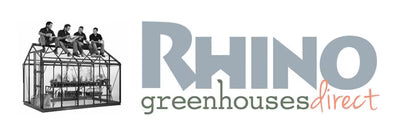A cold frame or a greenhouse, which is the best option for your garden? This guide takes you through the key differences between the two and the gardening benefits each choice can provide.
Let's start with the basics.
What is a cold frame greenhouse?
A cold frame greenhouse is a small, enclosed structure that helps gardeners extend the growing season by protecting plants from cold, wind, and frost. It is usually a box-shaped frame with a transparent lid made from glass or polycarbonate that lets in sunlight while trapping heat inside. To give you an idea of size, the Rhino Cold Frame might measures 2.5ft x 3ft.
Cold frames create a sheltered microclimate that is perfect for raising plants from seed and hardening off young plants before moving them into the garden. They also provide valuable protection for delicate plants during frosts and the colder autumn and winter months.

What is a greenhouse?
Greenhouses are larger structures that provide more growing space, often enough to walk inside and garden comfortably throughout the year. With transparent walls and roof, they capture sunlight and retain heat, offering space to grow a wide variety of plants in all seasons.

Cold frame vs greenhouse
|
Feature |
Cold Frame |
Greenhouse |
|---|---|---|
|
Size (Rhino sizes) |
2.5x3ft |
From 6x4ft to 20x20ft |
|
Design |
Box with a transparent lid |
Full structure with transparent walls and roof |
|
Climate Control |
Relies on natural heat and sunlight only |
Can include vents, heating, shading, and irrigation |
|
Best For |
Hardening off seedlings, early starts, overwintering hardy plants |
Year-round growing, wide range of vegetables, fruit, and flowers |
|
Flexibility |
Portable and easy to move |
Permanent garden feature |
|
Cost and Space |
Affordable, compact option. The Rhino Cold Frame is £495 |
Bigger investment, needs more space. Rhino greenhouses start from £1,449 |
|
Longevity |
Ideal for seasonal use, durable |
Built for year-round gardening. Durable. |
The key differences explained
Maintenance and durability
Cold frames are low-maintenance, usually requiring little more than an occasional clean. Quality models use strong materials like aluminium and toughened glass, which give them the strength to withstand the elements. Greenhouses naturally involve more upkeep, from checking glazing and vents to keeping gutters clear, but they are designed as permanent garden features that stand the test of time.
Growing conditions
Cold frames create a cosy microclimate at ground level that is perfect for nurturing seedlings and hardening plants. A greenhouse allows for full climate control with features like automatic roof vents, side louvres, and heating systems. This makes it possible to grow salad leaves in winter, tomatoes in summer, and a wide variety of plants all year.
Mobility vs permanence
Cold frames are portable and can be repositioned in the garden to catch the best light. Greenhouses are permanent structures that become part of your garden design. They not only transform your growing but can also add to your property’s appeal.
Cost over time
Cold frames are an affordable entry point, ideal for beginners or smaller gardens. Greenhouses are a bigger upfront investment, but with their longevity and guarantees of 20 years or more, they offer excellent value in the long run. It's worth noting that both Rhino Cold Frames and Greenhouses all come with a 25 year guarantee.
Aesthetic and garden design
A cold frame tucks neatly into the garden, blending in alongside beds and borders. A greenhouse makes a stronger visual statement and, depending on the finish and style, can become a centrepiece that enhances the character of your outdoor space as much as it supports your growing.
Security and protection
Cold frames protect plants from frost and sudden temperature drops at ground level. Greenhouses provide an even more secure environment, fully enclosing your plants against harsh weather, pests, and wildlife.
Final thoughts
Why choose a cold frame?
Cold frames are a good option if you do not have the space or budget for a traditional greenhouse. Built with a sturdy frame and clear lid, they sit low to the ground, bathing your plants in natural light while shielding them from the chill. Their smaller size also provides versatility, making them easy to move around the garden whenever you want.
Cold frames are simple to set up and require very little maintenance. With fewer moving parts and no need for heating or electrics, they offer a straightforward way to protect plants. They are ideal for gardeners who are just starting out or those who want reliable protection without the commitment of a full greenhouse.
Why choose a greenhouse instead of a cold frame?
The main difference is space. A greenhouse gives you much more room to grow and provides a controlled environment with vents, louvres, and optional heating. This makes it possible to grow crops year-round and to experiment with a wider range of plants.
Greenhouses need more planning and a little more maintenance than a cold frame, but they reward you with a growing space that can last for decades. Many models, including Rhino greenhouses, are designed with durability in mind and come with long guarantees to provide peace of mind.
Is there something in between?
Yes. Our Rhino Mini Patio Greenhouse bridges the gap. At 2ft x 4ft, it is larger than a cold frame but more compact than our smallest 6x4 Rhino. It is a great solution for gardeners with limited space who still want the benefits of a true greenhouse environment.







